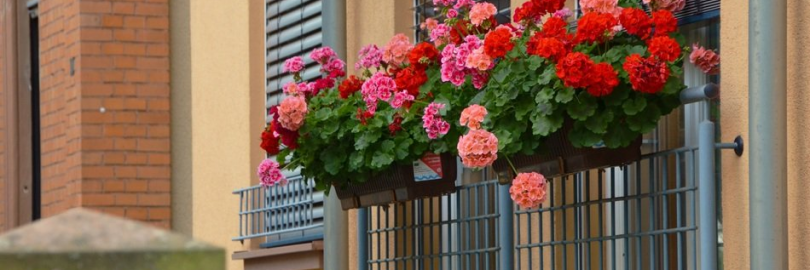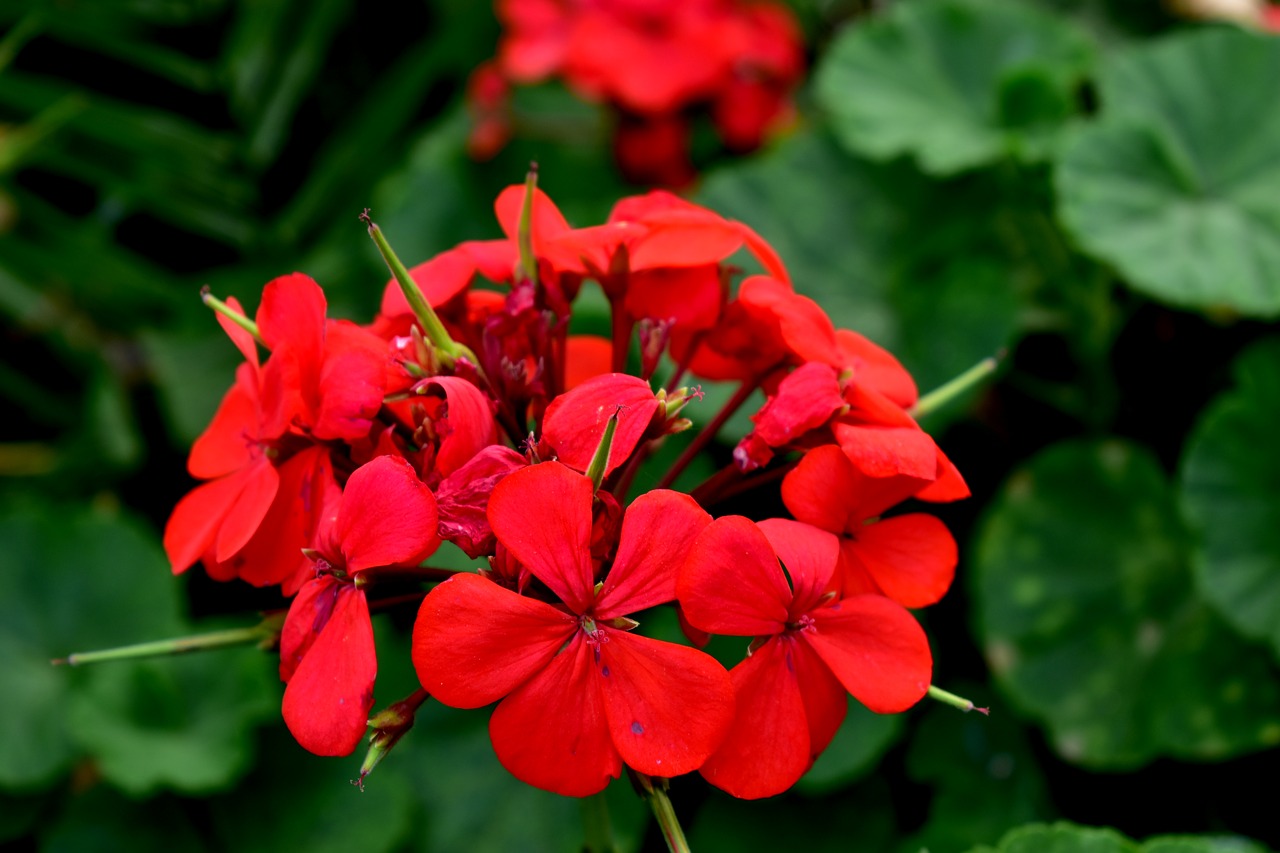
Geranium Plants Care: Growing and Caring Tips For You (9% Cashback)
Geranium Plant Overview
Geraniums are also called Crane's Bill because of the resemblance with its seed capsule. It's native to South Africa but can also be found all over the world. They are found throughout the temperate regions of the world and the mountains of the tropics, but mostly in the eastern part of the Mediterranean region.
An extremely versatile flowering plant, geraniums can be grown as annuals, biennial, perennials or indoor plants. They are most frequently grown outdoors in planters. Geraniums are appreciated for their long blooming season that starts in spring and can last into fall. If plants are kept above 45 to 50 degrees, they may also bloom in winter.

[copyright:pixabay.com]]
Types of Geranium
It has over 400 species with a wide range of variety in shapes, sizes, height, fragrances, and foliage. Some Geraniums are tailing, some are upright and some have single bloom while some have double.
There are four common categories of annual geraniums: zonal, ivy-leaf, regal and scented-leaved. Technically, the annuals referred to as geraniums belong to the genus Pelargonium. Most pelargoniums, or annual geraniums, are available in shades of red, pink, purple, lavender and white.
Common garden or zonal geraniums (Geranium x hortulanum)
The most popular are zonal geraniums. These upright geraniums' leaf margins are often scalloped, zoned orvariegated. They're called zonal, because of the bands, or zones, of color in their leaves. They produce an upright, ball-shaped flower head. Flowers are borne in large, showy clusters and may be single or double. Flower colors include red, burgundy, lavender, pink, salmon, orange, white, and bicolor. Zonal geraniums can be grown from cuttings or seed.

[copyright:James St. John on commons.m.wikimedia.org]]
Ivy geraniums (Geranium peltatum)
Ivy geraniums (also called trailing geraniums) have ivy-shaped leaves and more vine-like or trailing growth habit. Flowers can be single or double and are available in colors similar to the common garden geranium. Their flowers are a little bit smaller. Plants perform well in hanging baskets and window boxes. Ivy geraniums are somewhat less heat tolerant than common garden geraniums and benefit from some afternoon shade.

Scented geraniums (Pelargonium scented-leaved group)
Plants have a wide range of leaf sizes, shapes, and colors. Leaves are normally scented with lemon, rose, peppermint, nutmeg, apple, oak, and other fragrances. Scented geraniums are excellent container houseplants. Flowers are normally white, pink, or lavender and are typically less showy than most other geraniums. The widely promoted "mosquito geranium" is a type of scented geranium. When the leaves are rubbed, brushed, or crushed, a citronella fragrance is released. It's advisable to plant these geraniums in containers, along paths and in other areas where they can be easily touched and can release their scents.

Martha Washington or Regal geraniums (Pelargonium x domesticum)
They are the cool-season annual geranium. They have upright, shrubby plants whose leaves have irregular teeth and crinkled margins. This group is noted for their large, ruffled flowers in white, pink, red, purple, yellow, burgundy, and bicolors. Regal geraniums require nights with consistently cool temperatures to produce flowers. Since these geraniums thrive in cooler temperatures, they are normally only sold as container plants in late winter or early spring. While they make wonderful houseplants for several weeks, they are typically discarded when flowering is complete.

Fancy-leaf or variegated garaniums
They are becoming popular in some areas of the US. They are selections or hybrids from the common or zonal group of geraniums that are noted for their distinctive, multi-colored foliage. Combinations of green, yellow, white, red, burgundy, bronze, or coral leaves make these attractive plants for both indoor and outdoor containers. Some have scented foliage. Plants have red, pink, lavender, or white flowers, but they are smaller and less showy than the common garden geraniums.

If you want to get one, don't forget to sign up at Extrabux (What is Extrabux?) , then you can enjoy up to 9% cashback from Extrabux! Sign-Up Bonus: Free to join it & get $20 welcome bonus!
How to Care for a Geranium Plant?
Geography
Winter hardy in zones 10-11, grown as an annual or over-wintered indoors in colder zones. Zonal geraniums grow in U.S. Department of Agriculture hardiness zones 9 through 12, which means this plant will die if the temperature goes lower than 20 to 55 F. So, this plant grows best in climates found in the southern U.S., California, and Hawaii.
Planting Season
Spring is the ideal planting time for geraniums. You'll want to wait until after your area's last hard frost. Many of the showiest varieties are propagated from rooted stem cuttings rather than seeds.With attentive care and favorable conditions, you can expect to see blooms through early fall.
Where to plant
If planting in the ground, space them 6-24 inches apart. If potting in a container, don't overcrowd the space. If you plant in containers you can bring them indoors to overwinter them, and you'll be able to enjoy them outdoors during the next spring and summer.
Sunlight
Most annual geraniums need a spot in full sun, except for the ivy geranium, which grows best in light shade. They need to be placed in an area where they will get plenty of sun - ideally six to seven hours per day. However, geraniums don't have to be in a full-sun environment; they can also grow well in partial sun or shade, adding to their versatility. Perennial geraniums, on the other hand, grow in either sun or shade, depending on the type. Both types benefit from protection from sun during the hottest part of the day in southern and western regions of the country.
Water
Geraniums prefer moist but well-draining soil. Nobody can really tell you how often you should water your geraniums considering that there are too many variants. Check the soil with a moisture meter every time before watering. If you don't have a moisture meter, try sticking your finger into the soil, 1 inch down. Water the geraniums when the soil is on the dry side. Over-watering is one of the most common mistakes people make when they start cultivating geraniums.
Soil
The perfect soil for geraniums is a loose soil with plenty of organic matter. If your soil is on the heavy side, incorporate peat, compost or perlite. Manure and vermiculite are not recommended. Zonal geraniums are not terribly fussy about soil pH but prefer a slightly acid soil of about 5.8 to 6.5.
Fertilizing
Geraniums require light fertilization. If you feed them too much, the foliage will flourish at the expense of the blooms. Although you may see it in your garden center, you don't need to purchase a specialty geranium fertilizer. For a gentle fertilization, mix 2 tablespoons of a water soluble 20-20-20 fertilizer into 1 gallon of water. Apply this solution every three weeks throughout the growing season.
Pruning
Spring
A week or two after planting, when the plants are established, prune the main stems by about one-third to encourage additional new stems to form. Several leaves should remain on each stem after pruning. Young geraniums commonly found at garden centers in spring usually have one or two main stems, generally with a few side shoots and flower buds. Proper pruning of these young plants in the spring encourages them to become bushy and many stemmed, a form that promotes abundant blossoms.
Summer
When the last blossoms on a flower head have faded, remove the flower stem at its base, a process called deadheading that encourages new flower buds to form. If plants begin to look leggy later in the summer, prune back some of the side stems to encourage new branching and keep the plant from becoming thin and tall.
Autumn
In these warm-winter areas, they can be left in the ground during fall and winter. In early spring, before new growth starts, the plants benefit from a hard pruning, leaving just a few inches of last year's growth above the soil line. In colder areas, you might dig up and pot geraniums to overwinter indoors, placing them in a sunny but cool spot. Deadhead an overwintered plant by cutting it back by about one-third and reducing water to keep it healthy until spring, when you can move it outdoors for another season.
If you want to find more deals on Geranium plants, you can visit yougarden.com;bloomingdirect.com;trueleafmarket.com;burpee.com;walmart with up to 9% cash back from Extrabux!

Extrabux is an international cashback shopping site, offering up to 30% cashback from 10,000+ Stores!
B&H Photo Video, Dyson, Woodland Direct, Ooni UK, Bed Bath and Beyond, TUSHY, Zoro, Anthropologie, 4seating.com, GDF Studio, simplehuman, Appliance Parts Pros, etc.
Join to get $20 welcome bonus now! (How does Welcome Bonus work?)
Recommendation
-

Apple Watch Ultra 2 Real vs. Fake Guide 2025: How To Tell Original From Fake?
-

Microsoft 365 A1 vs. A3 vs. A5: Full Comparison & Verdict 2025
-

Is Turkish Airlines Good for International Flights?
-

Top & Best 12 Sneaker Apps/Websites for Raffles, Releases & Restocks in 2025
-

7 Best Gift Card Exchange Sites - Buy, Sell and Trade Discount Gift Card Safely and Instanly!










